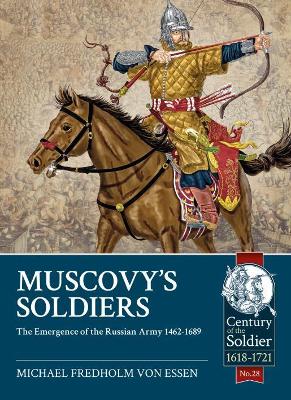Century of the Soldier
7 total works
The book describes and analyses the emergence of the early modern Russian army, before the military reforms introduced by Tsar Peter the Great brought it in line with developments in Western Europe. It will be shown that Tsar Peter's reforms, although decisive, rested on a legacy of previous reforms. Yet, the origin of the early modern Russian army can be found in the East, not the West. The close association during the Middle Ages with the Mongol Golden Horde had transformed the Muscovite military system into a Eurasian one. In the sixteenth and seventeenth centuries, links with the Northern Caucasus and Siberia brought further Oriental influences into the Russian military system. While the Mongol legacy of the early Muscovite army has been described elsewhere, the real and continuous impact of Oriental influences in the early modern Russian army has not yet been detailed. Besides, the detailed information on the Russian army in 1673/1674 which can be found in the military handbook then produced by a Swedish intelligence officer has never been fully used in English-language works. This information shows that by the second half of the seventeenth century, Russia already had an army that although not up to date according to Western standards, still was able to hold its own against both Western and Eastern adversaries. The book ends with 1689, when Tsar Peter's reign began and Russia's border in the east with China was negotiated.
The book describes and analyses the early modern Swedish army, with a particular emphasis on the reforms introduced by King Gustavus Adolphus before and during the Thirty Years War. Furthermore, the book expands our understanding of the Swedish army during the Thirty Years War by also focusing on its operations on the eastern front, against Russian and Polish opponents, and not only on the better-known operations in Germany against the Catholic League and the Holy Roman Empire. Sweden had a long history of conflict with neighbouring countries, and the reforms introduced by King Gustavus Adolphus had their origin in wars fought in the early seventeenth century, before or in the early phases of the Thirty Years War. The Kalmar war with Denmark, the Novgorod and Pskov campaigns in Russia, the conquest of Livonia, and the war with Poland played important roles in preparing the Swedish army for the wars on the continent from 1630 onwards. While some of the technical and tactical innovations attributed to the Swedish Army in the Thirty Years War are myths, others were real. Possibly of yet more enduring importance were the Swedish Chancellor Axel Oxenstierna's administrative reforms. A conscription system was established which consistently managed to raise troops, despite the small population of Sweden and its territories. A logistics system was introduced which could supply the armies, despite the vast geographical depth of operations. The intelligence service was developed into a comprehensive support establishment to military operations. It is fair to say that the Swedish army that entered the Thirty Years War and the organisation that enabled it formed the foundation for the subsequent Swedish rise to regional great power status. While the army of Gustavus Adolphus has been described elsewhere, the book includes current research that has not yet appeared in the English language. It also, unlike most previous works, explains how the Swedish experiences on the eastern front influenced Gustavus Adolphus and his views on how to build a modern army that could challenge the established great powers on the continent.
The book describes and analyses the Scanian War, which was fought from 1675 to 1679 between, on one side, primarily Brandenburg and Denmark-Norway and, on the other, Sweden. The war was mainly fought in Scania, the former Danish lands along the border with Sweden, and in northern Germany. The Danish objective was to retrieve Scania which, a generation earlier, had been captured by Sweden and ceded by Denmark. However, the Danish invasion of Scania was defeated by the young Swedish King Charles XI. Although the Danish fleet was victorious at sea, and an alliance headed by Brandenburg defeated the Swedes in Germany, the subsequent peace negotiations resulted in no major territorial changes. Danish partisans continued guerrilla operations in Scania for years, yet the former Danish territories remained in Swedish hands. The Scanian War was bloody, even by contemporary standards, and from a military point of view, quite inconclusive. Yet, Sweden's experiences in the Scanian War laid the foundation for the first substantial reform of the Swedish army since the Thirty Years' War. Based on what he had learnt, King Charles XI restructured the Swedish army and established a comprehensive military system that enabled Sweden to repeatedly mobilise trained armies during the even more devastating Great Northern War (1700-1721) which followed a generation later. Moreover, several recent archaeological excavations have increased our knowledge of the Scanian War, as well as the conditions of late seventeenth-century battles. The book describes the war and its results, and summarises the archaeological findings.
The book describes and analyses the 'Swedish Deluge' (potop szwedski), the devastating 1655-1660 wars fought between Sweden, the Polish-Lithuanian Commonwealth, Brandenburg-Prussia, Muscovite Russia, Transylvania, Cossack Ukraine, the Tatar Khanate of Crimea, and the Holy Roman Empire during the reign of Swedish King Charles X Gustavus, an experienced former general from the Thirty Years' War. By invading the Polish-Lithuanian Commonwealth, King Charles saw an opportunity to put an end to the Polish King's claim to the Swedish throne and to gain additional territories which would enable him to control the Baltic Sea maritime trade. The book focuses on the Swedish-Commonwealth war, which provoked the political and military collapse of the Commonwealth. However, since this conflict cannot be disentangled from the simultaneous wars between the Commonwealth and Muscovy, from 1654 to 1667, and between Sweden and Muscovy, from 1656 to 1661, they are described as well. Meanwhile, the Ukrainian cossacks fought for freedom from what they perceived as the oppression of the Commonwealth. Michael Fredholm von Essen presents new research on a war previously seldom described in English. Moreover, the book explains the continued development of the Swedish Army after the Thirty Years' War. It also provides full details on the dissimilar military systems of the Polish-Lithuanian Commonwealth, Brandenburg-Prussia, Muscovite Russia, Cossack Ukraine, Transylvania, the Crimean Tatar Khanate, and the Imperial expeditionary forces engaged in the Swedish Deluge.






